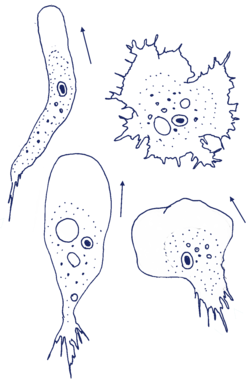Biology:Rhizamoeba
| Rhizamoeba | |
|---|---|

| |
| Different monopodial shapes of Rhizamoeba (clockwise from top left): worm-like, static, flattened, clavate. | |
| Scientific classification | |
| Domain: | Eukaryota |
| Phylum: | Amoebozoa |
| Class: | Tubulinea |
| Order: | Leptomyxida |
| Family: | Rhizamoebidae |
| Genus: | Rhizamoeba Page 1972 em. Smirnov et al. 2016 |
| Type species | |
| Rhizamoeba polyura Page 1972
| |
| Species | |
Rhizamoeba is a small genus of free-living marine naked lobose amoebae in the monotypic family Rhizamoebidae[1] in the order Leptomyxida.[2][3] It is most closely related to Leptomyxa and Flabellula, and some species have been moved to Leptomyxa due to molecular data.[1]
Morphology
Members of Rhizamoeba are characterized by their morphology when they move, which is usually monopodial (with a single ramification), alternating between a slug-like shape and a fan shape. They have either one nucleus or multiple (less than 50) nuclei.[1]
Classification
The paraphyly of the genus caused the transfer of two previously rhizamoeban species into Leptomyxa: R. australiensis and R. neglecta. As a result, only 3 species are currently confirmed as Rhizamoeba:[1]
- Rhizamoeba saxonica Page 1974
- Rhizamoeba polyura Page 1972
- Rhizamoeba matisi Mrva in Smirnov et al. 2017
Other possible species are not yet confirmed due to lack of published data or poor documentation.[1] Some of these are: R. schnepfii Kühn 1996/97 (considered nomen dubium since it has not been deposited to any culture collection), Trichamoeba caerulea Schaeffer 1926 and Trichamoeba clava Schaeffer 1926 (both transferred to Rhizamoeba in 1980[4] but poorly documented), Amoeba clavarioides Penard 1902 (identified as R. clavarioides through light microscopy[5]), Polychaos timidum Bovee 1972 (identified as R. timidum through light microscopy[6]), etc.
References
- ↑ 1.0 1.1 1.2 1.3 1.4 Smirnov, Alexey; Nassonova, Elena; Geisen, Stefan; Bonkowski, Michael; Kudryavtsev, Alexander; Berney, Cedric; Glotova, Anna; Bondarenko, Natalya et al. (2017). "Phylogeny and Systematics of Leptomyxid Amoebae (Amoebozoa, Tubulinea, Leptomyxida)". Protist 168 (2): 220–252. doi:10.1016/j.protis.2016.10.006. ISSN 1434-4610. PMID 28343121. https://www.sciencedirect.com/science/article/pii/S1434461016300670.
- ↑ "Phylogenetic placement of diverse amoebae inferred from multigene analyses and assessment of clade stability within 'Amoebozoa' upon removal of varying rate classes of SSU-rDNA". Mol. Phylogenet. Evol. 47 (1): 339–52. April 2008. doi:10.1016/j.ympev.2007.11.015. PMID 18180171.
- ↑ "Correct identification of species makes the amoebozoan rRNA tree congruent with morphology for the order Leptomyxida Page 1987; with description of Acramoeba dendroida n. g., n. sp., originally misidentified as 'Gephyramoeba sp.'". Eur. J. Protistol. 44 (1): 35–44. February 2008. doi:10.1016/j.ejop.2007.08.001. PMID 17905574.
- ↑ "Amoeben", Natura 77: 62–72, 1980
- ↑ Siemensma, Ferry J. (January 31, 2021). "Rhizamoeba clavarioides". https://arcella.nl/rhizamoeba-clavarioides.
- ↑ Siemensma, Ferry J. (January 31, 2021). "Rhizamoeba timidum". https://arcella.nl/rhizamoeba-timidum.
Wikidata ☰ Q4689919 entry
 |

